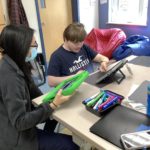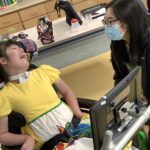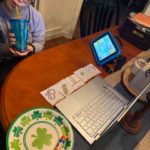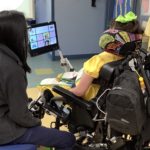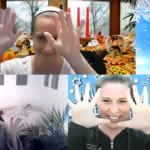Better Speech and Hearing Month: Kennedy Day School
As Better Hearing & Speech Month continues, learn more about speech therapy at Kennedy Day School from Alex Mack and Stacey Swift, Speech-Language Pathologists.
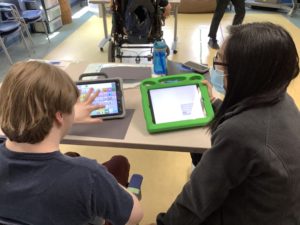
If you walk into any classroom in the Kennedy Day School (KDS), chances are you’ll hear (and see!) many different greetings, offered in many different ways – a student pointing to a picture communication symbol representing “Hello,” another student using her simple voice output communication aid (VOCA) with the pre-recorded message, “Hi!,” and another student using his eyes to activate a speech-generating device to ask you, “What’s up?” Our students are experts at using their voices in their own ways, and the speech-language pathologists (SLPs) who work in KDS are there to help make sure they have every opportunity to do just that.
KDS SLPs provide speech-language, literacy, feeding, and augmentative and alternative communication (AAC) services to approximately 60 medically complex students between the ages of 3 – 22. We work closely with each student’s interdisciplinary educational team to develop individualized communication systems that enhance independent communication skills across various settings and contexts. Students participate in individual speech-language therapy sessions, as well as in small classroom groups, and co-treatment sessions with music therapists, occupational therapists, physical therapists, and teachers for the visually impaired (TVIs). These sessions typically focus on a wide range of communication and language skills, including self-advocacy, social exchanges, and learning core vocabulary (i.e., words that are commonly or frequently used across many settings with a variety of communication partners).
In addition, we provide comprehensive AAC evaluation services and recommendations to students and their families in conjunction with the outpatient Augmentative Communication Clinic (AC Clinic). This unique partnership allows us to see through the process of acquiring a dedicated communication device through from start to finish – that is, completing an extensive evaluation, making appropriate recommendations for systems and/or strategies to maximize a student’s current communication ability, as well as to foster his or her future language development, coordinating the lengthy process of gathering necessary paperwork from a variety of sources (e.g., primary care physician, caregivers, etc.), submitting all required information to the necessary parties, and then, coordinating and collecting trial data to support device purchase via insurance funding. It can certainly be a challenging process, but well worth it to give our students the opportunity to share their thoughts with their families, friends, and teachers.
So, the next time you have a chance, come visit us for a chat. Just be prepared to stay for a while – we have a lot to say!
